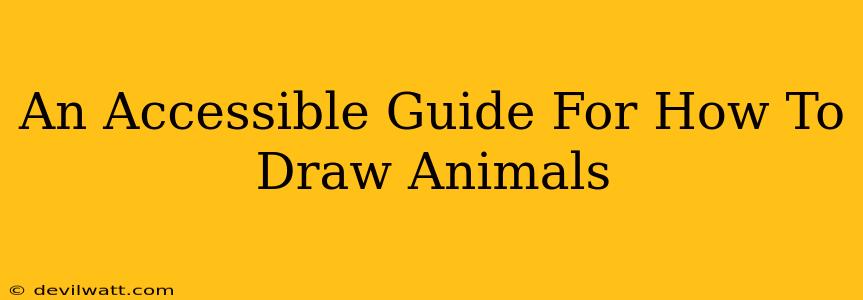So you want to draw animals? Fantastic! Whether you're a seasoned artist looking to refine your skills or a complete beginner picking up a pencil for the first time, this guide offers accessible techniques to help you bring animals to life on paper. We'll break down the process into manageable steps, focusing on fundamental shapes and observation skills. Get ready to unleash your inner wildlife artist!
Understanding Animal Anatomy: The Foundation of Realistic Drawings
Before diving into specific animals, let's lay a solid foundation. Understanding basic animal anatomy is crucial for creating believable depictions. Don't worry; we're not talking about complex skeletal structures! We'll focus on simplified shapes.
Breaking Down the Body into Simple Shapes
Think of animals as collections of basic shapes: circles, squares, triangles, and cylinders. A dog's body might be a long cylinder, its head a circle, and its legs cylinders tapering down to smaller circles (paws). This simplification makes it easier to capture the overall form before adding details.
- Practice: Start by sketching various animals using only these basic shapes. Don't worry about details; focus on getting the proportions right.
Observing Proportions and Movement
Animals, like humans, have specific proportions. For example, a horse's legs are significantly longer than its body, whereas a cat's body is relatively longer than its legs. Observing these proportions is key to accurate representation.
- Reference Images: Use photographs or videos of animals as references. Pay close attention to how their bodies move and how their limbs are positioned.
Drawing Specific Animals: Step-by-Step Tutorials
Now let's get into the fun part: drawing specific animals! We'll start with a few common subjects and provide step-by-step instructions.
How to Draw a Cat
- Basic Shape: Begin with a large oval for the body and a smaller circle for the head. Attach them smoothly.
- Legs and Tail: Add four small cylinders for the legs, tapering down to circles for the paws. Sketch a long, curved line for the tail.
- Facial Features: Add two triangles for the ears, and smaller circles for the eyes and nose.
- Details: Refine the shapes, adding fur texture with short, light strokes.
How to Draw a Dog
- Body: Start with a longer oval or cylinder for the body, slightly wider at the chest.
- Head: Add a circle for the head, connected to the body.
- Legs: Four slightly curved cylinders form the legs.
- Tail: Draw a wagging tail.
- Features: Add eyes, ears, and a nose, adjusting shapes based on the dog breed.
How to Draw a Bird
- Body: Start with a rounded shape for the body.
- Head: Add a smaller circle for the head.
- Wings and Tail: Sketch two slightly curved shapes for the wings, and a triangle or fan shape for the tail.
- Beak and Feet: Draw a pointed beak and small clawed feet.
Mastering Animal Expressions and Details
Once you’re comfortable with the basic shapes, it’s time to add personality!
Capturing Expressions
Animal eyes are incredibly expressive. A wide-eyed look conveys fear or surprise, while narrowed eyes might indicate anger or focus. Pay attention to subtle changes in the position of ears and mouths to portray different emotions.
Adding Texture and Detail
Fur, scales, feathers – each animal has its unique texture. Experiment with different shading techniques to create realistic textures. Use short strokes for fur, overlapping scales, and fine lines for feathers.
Practice Makes Perfect!
Drawing animals is a journey, not a race. The more you practice, the better you’ll become. Don't be afraid to experiment, make mistakes, and learn from them. Most importantly, have fun! Remember to keep practicing, observing, and refining your skills. Happy drawing!

